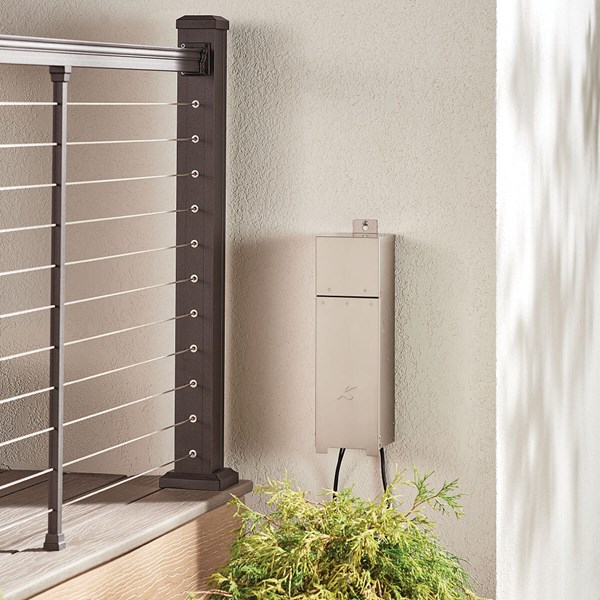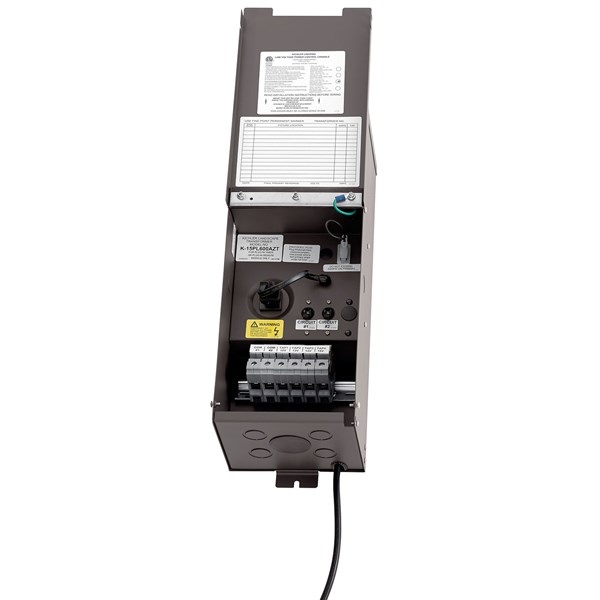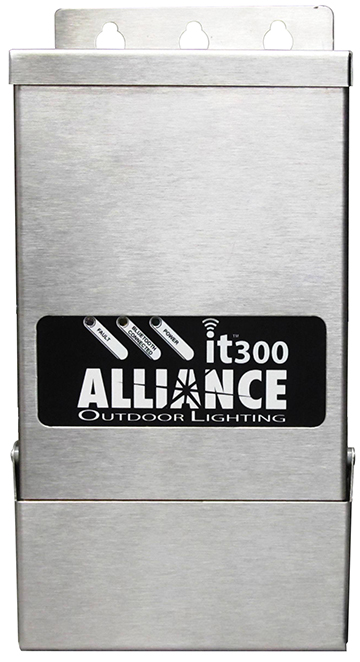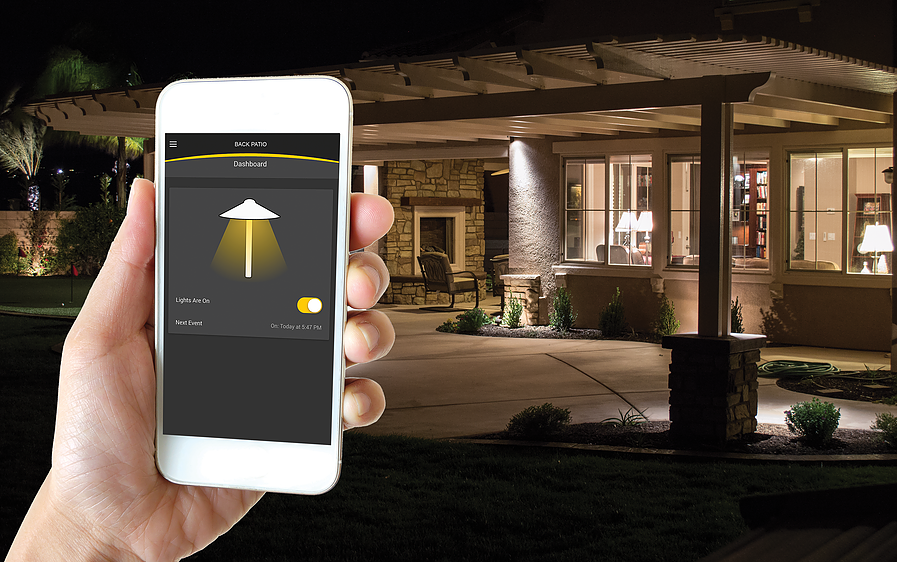When installing 12V landscape lighting, you want to make sure you also install the right sized low-voltage transformer. Low-voltage transformers are devices that reduce a higher input voltage to a lower output voltage. Low voltage transformers are those that operate at 30 volts or lower. Low voltage landscape lighting primarily uses 12 volts, but 24 volt systems are also available. Many contractor-grade transformers have multiple voltage taps allowing for more precise adjustment of voltages supplied to each fixture run.
Steps to select the right transformer size
Add up all the lamp wattages you expect to connect to each individual wire run and the transformer as a whole. (It’s advisable to use the maximum allowable wattage of each fixture so a system is not accidentally undersized, but this is left to the contractor’s discretion.) This will give you a minimum starting point for estimating the transformer size needed for the job.
Compare your total lamp wattage to the available transformer sizes (typically 300, 600, 900 and 1200W). If you add up 600 watts, then use a 900-watt transformer. By code, transformers should be derated to 80% of their capacities so a 900W unit should be derated to 720W max (900 x .8).
Measure each expected wire run length from transformer location to approximate fixture location. If you have very long runs or heavily loaded runs, this will increase voltage drop. Many transformers have multiple voltage taps (12V – 15V; 12V – 18V, 12V – 22V, etc.). Just make sure that the unit you select gives you sufficient capacity to compensate for whatever your voltage drops per run are calculated to be. For example, a 12V – 15V unit provides a maximum of three (3) extra volts so if your calculations show a voltage drop of four or more, then you will need to adjust some aspect of your design: reduce the load, use thicker wire, move the transformer closer, specify a unit with higher voltage taps, etc.
Calculate Amps Using Ohms Law
Using Ohms Law (Watts = Amps x Volts), divide total expected watts by the voltage and you will get the maximum amps. Cross-check this number against the max amp load label on the transformer. Do not exceed this number or the transformer will be overloaded. This can be a tripping nuisance and a fire hazard.
300W/120V = 2.5A 600W/120V = 5.0A 900W/120V = 7.5A 1200W/120V = 10.0A
Long wire runs and heavy loads force the use of higher voltage taps and thicker wire to compensate. Another option is to run 120V power to the farthest areas needing light, and installing a transformer in a remote location. This keeps the wire runs shorter and the need for higher voltage taps lower. The higher the voltage taps used, the more load the transformer feels like it’s using. That can eat up capacity on a transformer.

How to Best Utilize a Multi-Tap Transformer
It’s important to calculate just how much voltage you need to push down the line to the fixtures so you can select the correct unit from the start. The sizing of a transformer is impacted by distance to lights, wire gauge, voltage levels, overall load, etc. Some transformers have terminal taps from 12V to 15V, some have an 11V tap, some go up to 22V.
If there are any particularly long or heavily loaded wire runs, then it is best to run a second calculation called the “voltage drop calculation.” This will allow desk calculations to be run so that transformer(s) and wire are not accidentally undersized thus compromising the job.
Total Length of Wire Run x Distance to Point of 1st Connection = Voltage Drop Cable Constant
Key points to remember:
Do not over-load transformers beyond their rated wattage or amperage capacities – this can cause over-heating and become a fire hazard.
The NEC (National Electric Code) requires that appliances which operate more than three (3) hours per day be derated to 80% of their capacity, so 300W x .8 = 240W max.
Lastly, make sure all copper wire strands are contained and tightly held inside the terminal block. If they are not secure, then arcing can occur, and this causes over-heating and can become a fire hazard.
Example Transformers
- Alliance Bluetooth IT Transformer Series
- Kichler Plus Series Transformer (200W, 300W, 600W) or Pro Series (100W, 200W, 300W, 600W)
- FXLuminaire Step Down Transformers

















I have a landscape lighting system with 19 kichler lights rated at 8.5 watts, for a total wattage of 161.5. The kichler transformer is rated at 200 watts. I just added another light rated at 2.5 watts. Since adding that light the system works some nights and not others. If total wattage is below the transformer rating 200 vs 164 including the newly added light, could this be the cause of the problem? The cable used is 12 gauge and longest run is about 45 feet. One run has 10 lights and the other 9 lights.
Your thoughts please.
Thank you for submitting your question in regards to the lighting issue you are having at your home.
While the wattage on the fixtures you mention is listed as 8.5 watts this does not count as the Volt Amperage. LED s typically run off of DC (direct current) electrical current and the electricity being provided by the home is AC (alternating current). Landscape LEDs typically have a converter in the fixture/lamp that converts the electricity to DC. This usually pulls an additional wattage consumption from the transformer in the form of an increase of 10-25% more than what the fixture is listed at. The 8.5 watt fixture you speak of from Kichler comes rated at 12.2VA. Running 19 of this fixture totals a VA of 231.8. I am shocked you have not ran into issues prior to this.
The only recommendation I can make to try and make work with what you have is to remove the additional light and is to confirm if you a have a multi-tap transformer. This gives you different electrical out puts of 12 volt, 13 volt, 14 volt and 15 volt. If so, try to move the leads into the 15 volt tap within the transformer. The higher the voltage the lower the amperage (this is a good thing for the system regardless). Hopefully this will lower the overall amperage of the system and will allow the lights you currently have to operate the way you had hoped for.
If this does not work, you will most likely have to replace the transformer and/or call a contractor.
I hope this helps.
Chuck Watterson, Lighting Product Manager
Thanks for sharing. It helps me to increase my knowledge.
I want to use a transformer to light up my flags. Right now I only plan on using two 5 watt lights. But in the future I plan on adding more lights. Is it ok to use a transformer that has more output that I need right now so that I can “add” more lights later?
Yes it’s okay to use a transformer that’s bigger than current load.
We also typically recommend using a 10 degree beam spread, but that kind of depends on how tall the flag pole is. The narrower the beam the further it goes and the brighter it is. Feel free to contact out lighting specialist Brooke Perin at 614-402-3017. She can walk you through any other questions. Thanks!
Hi there. I need some help (I have no clue about all of these at all). I installed low voltage LED landscape lighting from Walmart. The only transformer it has for this particular model (QuickFit – Better Homes & Garden) is rated 35watts. Each LED light post requires 1.5watts, which mean, i should install 23 lights before going over the 35 watts transformer.
My question is that, can I install 27 lights ? (total of 40.5watts) using one 35 watts transformer ? Will the transformer overheat ? or will something bad happens? I figure that if the transformer can SUPPLY only 35 watts max, and if I use 27 lights, each light will basically receive 1.29 watts only instead of 1.5 watts, which is OK. Am I correct ? OK, I did test using 27 lights, and all of them turned on with no issue. I could have used 2 transformer, but i prefer to use one only.
I am just concern about overheating the transform.
Help please….and thanks!
Please contact Brooke Perin our lighting specialist at 614-402-3017. She will be able to help you through any questions you may have. Thank you for reaching out to us!
Question. Was aware of 80% rule but was speaking with manufacturers tech dept. and was told not to drop below 50% either. This was concerning low voltage LED yard lites. Wasn’t aware and don’t understand the min. Example. 12 volt 120 watt. transformer with 40 watts worth of LED lighting is too little load.
Keep up the good piece of work, I read few content on this internet site and I think that your blog is rattling interesting and holds sets of excellent info .
Great write-up, I am normal visitor of one’s blog, maintain up the excellent operate, and It is going to be a regular visitor for a long time.
This from an electrician who is now a landscape lighting installer:
Here’s the answer you are looking for but this is the NEC so nothing is easy and to the point. You need to tie it all together.
210.20(A) Continuous and Noncontinuous Loads.
Where a branch circuit supplies continuous loads or any combination of continuous and noncontinuous loads, the rating of the overcurrent device shall not be less than the noncontinuous load plus 125 percent of the continouos load.
Article 100 – Definitions
Continuous load. A load where maximum current is expected to continue for 3 hours or more.
(Lighting is considered to be continuous)
The table you referenced – Table 210.21(B)(2) is for known loads to be plugged into a receptacle. This is further discussed in 210.23(A)(1) and (2)
Receptacle loads for dwelling units are included in general lighting circuits with no independent load assigned to a receptacle and therefore a dwelling branch circuit may include as many receptacles the electrician wishes. The exceptions are the (2) kitchen small appliance circuits, (1) washer circuit … etc. This is referenced in 220.14(J).
Commercial buildings receptacle loads are based upon 180 volt-amperes / watts or 1.5 amperes each. So since these are general receptacles with unknown loads you may install 20 amp breaker / 1.5 amp = 13 receptacles. These are noncontinouos loads so as long as you do not exceed the breaker rating is acceptable. This is referenced in 220.14(I).
So 12 amp load is the most allowed to be installed on a 15 amp lighting circuit. 12 amp x 125% = 15 amp breaker. 15 amp breaker x 80% = 12 amp.
I would venture to guess a lot of electricians “know” the 80% rule but couldn’t tell you why.
Every class I’ve ever attended (lighting association, manufacturers, etc.) have highlighted the importance of adhering to the 80% rule as it applies to load on the transformer and wire as well. Most lighting installations are not installed on dedicated circuits so it’s a good practice to have a buffer to allow for temporary, additional loads (power tools, chargers, holiday lights, etc.) Additionally, if you refer to the National Electrical Code (2014) Table 210.21(B)(2) it makes reference to Maximum Cord-and-Plug-Connected Load to Receptacle. It states that a 15 Amp Circuit Maximum Load (Amps) should be 12A, and that a 20 Amp Circuit Maximum Load (Amps) should be 16A. This corresponds to 80%. Please let me know if you have any other questions. Happy to help.
Can anyone show an NEC reference for this “80% rule”? I am well aware of the noncontinuous + 125% continuous stipulations for load calcs, but I don’t see why you couldn’t run a transformer at 100% of its rating.
Many electricians think that LV transformers are rated 100%
I believe it’s the #1 reason for transformer failure.
Over heating and over driven transformers are expensive repairs.
Agree. Most manufactures suggest utilizing only 80% of a transformer’s rated output. That leaves some buffer to add some additional lights. Often more load is applied because people miscalculate or do not know to watch how much amperage is being demanded.